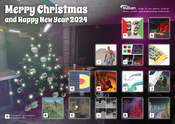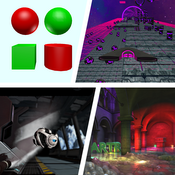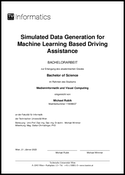Show images of current Projects | Years: 2022 - 2023 - 2024.
X-Mas Cards
Every year a christmas card showing aspects of our research projects is produced and sent out.Advanced Computational Design
Toward Optimal Path Guiding for Photorealistic Rendering
Joint Human-Machine Data Exploration
Wider research context
In many domains, such as biology, chemistry, medicine, and the humanities, large amounts of data exist. Visual exploratory analysis of these data is often not practicable due to their size and their unstructured nature. Traditional machine learning (ML) requires large-scale labeled training data and a clear target definition, which is typically not available when exploring unknown data. For such large-scale, unstructured, open-ended, and domain-specific problems, we need an interactive approach combining the strengths of ML and human analytical skills into a unified process that helps users to "detect the expected and discover the unexpected".
Hypotheses
We hypothesize that humans and machines can learn jointly from the data and from each other during exploratory data analysis. We further hypothesize that this joint learning enables a new visual analytics approach that reveals how users' incrementally growing insights fit the data, which will foster questioning and reframing.
Approach
We integrate interactive ML and interactive visualization to learn about data and from data in a joint fashion. To this end, we propose a data-agnostic joint human-machine data exploration (JDE) framework that supports users in the exploratory analysis and the discovery of meaningful structures in the data. In contrast to existing approaches, we investigate data exploration from a new perspective that focuses on the discovery and definition of complex structural information from the data rather than primarily on the model (as in ML) or on the data itself (as in visualization).
Innovation
First, the conceptual framework of JDE introduces a novel knowledge modeling approach for visual analytics based on interactive ML that incrementally captures potentially complex, yet interpretable concepts that users expect or have learned from the data. Second, it proposes an intelligent agent that elicits information fitting the users' expectations and discovers what may be unexpected for the users. Third, it relies on a new visualization approach focusing on how the large-scale data fits the users' knowledge and expectations, rather than solely the data. Fourth, this leads to novel exploratory data analysis techniques -- an interactive interplay between knowledge externalization, machine-guided data inspection, questioning, and reframing.
Primary researchers involved
The project is a joint collaboration between researchers from TU Wien (Manuela Waldner) and the University of Applied Sciences St. Pölten (Matthias Zeppelzauer), Austria, who contribute and join their complementary expertise on information visualization, visual analytics, and interactive ML.
FWF Stand-alone project P 36453
DOI: 10.55776/P36453













